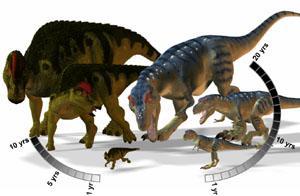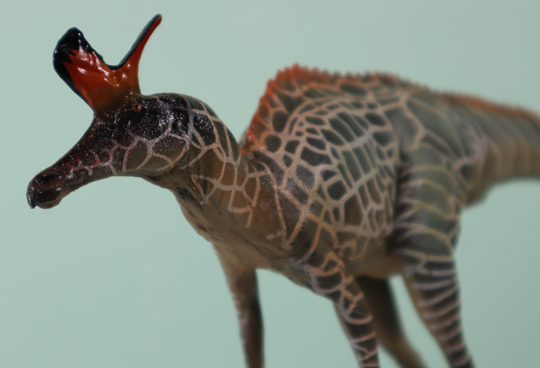New Research reveals Hadrosaur Survival Strategy
Being a 30 foot long, relatively slow moving plant-eating dinosaur at the very end of the Cretaceous spells trouble when you share a habitat with Tyrannosaurus rex. Without horns or body armour for protection such animals might find themselves vulnerable to attack from one of the most formidable predators ever to roam the planet. However, new research from a team of American scientists have come up with an interesting survival strategy, simply grow quicker and mature faster than the animals trying to eat you.
Duck-billed Dinosaur
In a scientific paper recently published in the Proceedings of the Royal Society of London B: Biological Sciences, the growth rates of a duck-billed dinosaur called Hypacrosaurus was compared to three carnivorous dinosaurs. The study revealed that the peaceful plant-eater grew faster than the tyrannosaurs and was able to breed at a much younger age, two evolutionary attributes that may have helped balance the scales in terms of survival for this relatively primitive lambeosaurine (the term given to describe duck-bills with ornate crests).
At least two species of Hypacrosaurus are known from the Late Cretaceous of Canada and the USA (Maastrichtian faunal stage), a number of good, well preserved specimens have been found and crucially they include eggs and youngsters in various stages of growth. By having a number of specimens of different ages to study palaeontologists can work out something of this animal’s ontogeny (growth and development).
Drew Lee, a postdoctoral fellow in Ohio University’s College of Osteopathic Medicine and co-author Lisa Noelle Cooper, a doctoral student at Kent State University and a researcher with the Northeastern Ohio University’s College of Medicine examined the fossilised bones of Hypacrosaurus and three meat-eating theropods that were contemporaries of this hadrosaur – two tyrannosaurs, T. rex and Albertosaurus plus the much smaller Troodon.
The research suggests that it took 10 to 12 years for Hypacrosaurus to become fully grown, reaching a maximum size of 10 metres in length. Tyrannosaurs, however, reached adulthood at an older age, indicating slower growth rates. The study indicates that T. rex for example, would have reached adult size after 20 to 30 years.
“Our duck-billed dinosaur grew three to five times faster than any potential predators that lived alongside it,” commented Lee. “By the time the duck-billed dinosaur was fully grown, the tyrannosaurs were only half grown – it was a huge size difference.”
The Hypacrosaurus seems to have reached sexual maturity at an earlier age, perhaps at only two or three years of age, being able to breed quickly is an effective survival strategy for a species.
“That’s another added bonus when facing predators – if you can keep reproducing, you’re set,” Lisa claimed. “It’s the stuff of evolution.”
Analysis Conducted
Lisa conducted the original analysis of the hadrosaur while an undergraduate student at Montana State University. Working with scientists Jack Horner and Mark Taper (both extremely knowledgeable with regards to late Mesozoic vertebrates). She looked at thin sections of the long leg bones of a specimen of Hypacrosaurus and counted and measured the growth rings, within the fossilised bones which each represent one year of life, or at least changes in growth rates to reflect dry and wet seasons.
“We were shocked at how fast they grew. If you look at a cross section of the bone of a nestling or even from within the egg, there are huge spaces in which blood supply was going through the bone, which means they were growing like crazy,” she said.
Drew Lee described Hypacrosaurus as a typical prey species for the large predators around North America at the end of the Age of Reptiles, comparing Hypacrosaurus to a common antelope of the African plains “the Thomson’s gazelle of the Late Cretaceous”.
The fossil record indicates that the duck-billed dinosaurs were an extremely successful group which is surprising as their fossilised bones don’t really give many clues to how these animals would have flourished in such a harsh environment. The other common group of large plant-eaters, the horned dinosaurs or ceratopsians had horns and bony shields to protect them from the fierce carnivores, on first sight the hadrosaurs seem to be very vulnerable. One factor in the hadrosaur’s survival could be that it grew up faster than the meat-eaters and it was faster growing when compared to the other large herbivores around at the time as well.
A Strategy for Survival – Grow Fast and Breed Young

Picture credit: Ohio State University
At least one study suggests that living animals employ this survival strategy as well, Lee said. Scientists have found that Killifish, a tiny freshwater fish found mainly in the Americas, mature faster when predators lurk. Anecdotal evidence suggests that creatures such as African ungulates (hoofed animals) grow big to create an advantage over lions, cheetahs and hyenas, he said. Researchers also see signs of this phenomenon in butterflies, toads, salamanders, guppies and some birds, Cooper added. The presence of predators may increase the pressure on a population of prey animals to survive and this may lead to faster growth rates and a decrease in the age of sexual maturity. In a population, those animals that possess the genetic qualities to be able to extract nutrients from their diet more effectively and to grow bigger may give them an edge over other animals that may not be able to compete as effectively. It is these “weaker” animals that fall prey to meat-eaters and the stronger animals go on to breed and pass on their genes to the next generation. In this way, the genetic health of the population is improved and the ability to produce quickly and grow fast becomes a trait within the entire population over time.
Dinosaur Growth Rates
Although palaeontologists are careful to preserve dinosaur fossils, they’ve also learned much more about growth rates, life spans, behaviour and sexual reproduction of dinosaurs in the past decade by cutting up the bones and taking a closer look at the clues they contain. Such research has offered a much more detailed picture of the relationships between different dinosaur species, including predator and prey. This has helped scientists to understand a little more about the relationships between different genera that co-existed
This work on the internal structure of fossil bones is a relatively new technique, only possible through the advances made in the study of fossils and in fossil preservation techniques. Interpreting the evidence can prove difficult, but as more specimens of certain types of dinosaur are discovered, this does allow scientists to form theories as to their growth rates and age of maturity. The hadrosaurs were an extremely successful group of Cretaceous dinosaurs, which along with the ceratopsians dominated the plant-eating mega fauna of the Late Cretaceous. Many species formed vast herds (evidence from trackways and bone beds), living in large herds would have been another effective survival strategy, just as is seen in herds of hoofed mammals such as caribou and zebra today.

A close view of the head and hatchet-like crest on the PNSO Lambeosaurus dinosaur model. A typical duck-billed dinosaur (lambeosaurine). Picture credit: Everything Dinosaur.
To view the PNSO model range including lambeosaurines: PNSO Age of Dinosaurs.
Recent work on another type of duck-billed dinosaur, a hadrosaurine nick-named Dakota by the research team working on the fantastically well preserved specimen, has provided another clue as to how these animals were able to survive the attentions of the tyrannosaurs.
CAT scans on the nearly complete fossil have revealed that this hadrosaur had larger hind quarters than previously thought. The powerful back legs would have helped this animal take up a bipedal posture and run quicker than earlier studies had shown, perhaps helping to escape from predators such as Tyrannosaurus rex. Being bigger and growing up fast may have helped these animals to escape the attentions of a pursuing predator. Without any body armour or horns to protect them, being able to outrun a meat-eater would have been a tremendous advantage.
To read more about this amazing discovery: Dinosaur Mummy unlocks Duck-Billed Dinosaur Secrets.
An update on the remarkable work being carried out on the fossil dinosaur known as “Dakota” has recently been published, to read more: Update on Dakota.
Lee, who recently published a study in the Proceedings of the National Academy of Sciences on the sexual maturity rates of dinosaurs, hopes to conduct more research on other types of dinosaur, those with reasonably numerous fossils to study. It is hoped that further work will be carried out on communities of dinosaurs, such as those of Allosaurus, Stegosaurus and Apatosaurus from the earlier Jurassic period to draw further conclusions on the fast growth survival strategy.
“This study is a stepping stone to a larger comparative study on community changes that impacted dinosaur evolution,” Lee said.
Everything Dinosaur stocks a large range of hadrosaur models, to view the model’s section on the company’s award-winning website: Dinosaur and Prehistoric Animal Models.
This article is an extract from the following source:
Ohio University (2008, August 6). Duck-billed Dinosaurs Outgrew Predators To Survive.






Leave A Comment